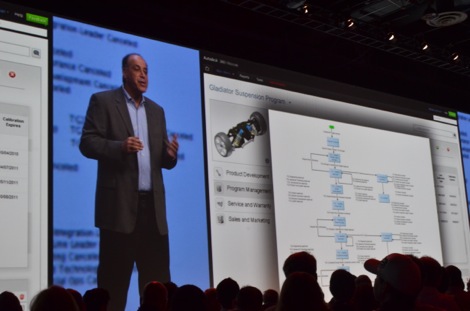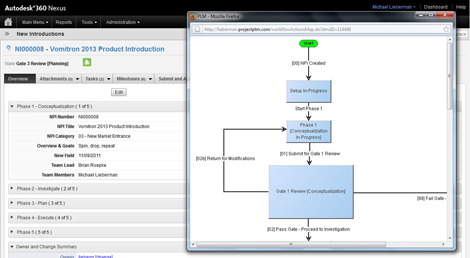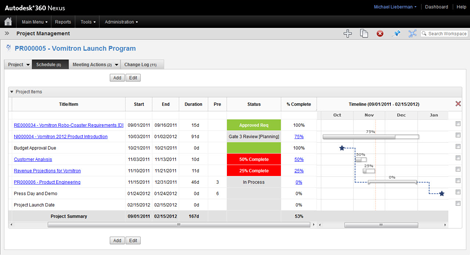
Uncle Carl, CEO of Autodesk, teases the assembled masses with Autodesk’s PLM offering before the mother lode is delivered later this afternoon
This has been talked about for sometime, ever since Autodesk’s CEO, Carl Bass, turned around his views on Product Lifecycle Management (this is the gentleman that said “the only people with a PLM problem are PLM vendors“) sometime around this time last year (see our interview with Carl here).
The last few weeks have seen tantalising snippets coming out in the mainstream media about where Autodesk is spending its development revenues and some teasers from the Autodesk Twitter Massive (If you’re interested, that would be @MikeWaktins and @robcohee) and a couple of things were pretty clear. Firstly, that Autodesk was getting into the PLM game. Secondly, that Autodesk was looking at the cloud to expand its offering in that space.
But it’s today, at Autodesk University, that we get to finally see what the company has been scheming up. And quite a thing it is. So let’s break it down.
Where Autodesk is now
At present, Autodesk’s data management solutions fall into two camps. Firstly, the Autodesk Vault product range. Supplied with all of Autodesk’s application suites, Vault is an PDM (Product Data Management) system. It excels at managing engineering workgroup data. CAD data of all flavours (2D, 3D, parts, assemblies etc.), and some documents that sit alongside that. There are solutions that sit alongside it (Autodesk Vault Workgroup to Professional). These focus on taking the data and spreading its use, but within an engineering context,whether that’s multi-sit capabilities or integration with ERP.
Then there’s Autodesk Buzzsaw (www.buzzsaw.com). This is a collaboration system, predominantly used in the AEC space, but still seeing some traction amongst Autodesk’s manufacturing customers. The goal here being to take data from Vault and open it up for collaboration purposes – whether that’s downstream use internally (such as manufacturing) or outside the firewall properly with a supply chain.
So what’s next?
The answer is that Autodesk is taking the lessons learned, combining them with a bunch of new technologies acquired over the last few years (Autodesk states that it has acquired 10 or more companies in the last 12 months which have remained unannounced and much of this has supplied the core technology for the new offering) to create Autodesk 360 Nexus. To take the official line first, Nexus is this:
Autodesk 360 Nexus is a new, cloud-based solution that will anchor Autodesk 360 for PLM with affordable, easy-to-use and simple-to-deploy software as a service that makes the benefits of PLM business applications available to business users anytime, anywhere — with less cost and risk.
Get that? No. Me neither. So let’s break it down.
From this point onwards, Autodesk is creating a new product group; Autodesk 360. Within that product group, you will find Autodesk 360 Nexus, Autodesk 360 Vault and Autodesk 360 Buzzsaw – both will remain much the same for the time being. Vault will remain inside the firewall for most customers, managing engineering and product data and workflow. Buzzsaw will remain as it does, providing supplier collaboration, though I would expect some variant for the manufacturing industry to come online soon.
Where the real new stuff is in Nexus.
Rather than expand out the Vault offering, what Autodesk has done is created a Cloud-based offering that layers on top of the core PDM-focussed vault. Think of it like this. The heavy client for design and engineering is likely to remain in place for some time. The sheer weight of 2D and 3D data means that it would be unfeasible for it to a purely cloud-based solution. So it makes sense to leave it as it is. It works, it works well and there are a tonne of customers already using it.
What Nexus does is synchronise with the Vault data and then make that fundamental data available for additional processes, workflows and tasks that are common when customers are looking at a PLM offering. At release, it’s thought that Nexus will provide the following:
- Project Management
- Requirements Management
- Quality & Compliance
- Supplier Management
- Service Management
Having had a chance to look at what’s there last week under NDA, the work that Autodesk has done is looking pretty damn good. The web-based UI is nothing new, but Autodesk has managed to make this look clean, current and modern – unlike some other PLM systems out there. That said, everything looks like anyone will be able to dive in and both extract the data they want from the system and provide the input and interaction they need – irrespective of tech savvy.

Autodesk 360 Nexus Homepage: Clear assignment of tasks in a modern, fully mobile interface

The analytics/admin side of things uses visualisation tools to give immediate feedback on where a project is at. Dynamically updated from the source data
The Projects and Requirement management tools look as you would expect. Track and formalise customer requirements, feed those into the New Product Introduction (NPI) process using customisable workflows. then feed into the design process, conducted in Vault. At the same time, project management is handled in Nexus, allowing those who favour quick, lightweight interaction over a heavy client to dive in and get the job done.

The Requirements Roamer lets you explore how a product’s requirements are linked together to build a greater understanding of what’s driving your product’s development

As you’d expect, workflow (in this case, for New Product Introduction) is built up graphically, making life much easier for the admin team/person
As things progress, the compliance module gives you tools to compare your current projects against all manner of environmental legislation such as RoHS, REACH etc. Of course, once the product is in use, then the service management lets you track service requests, maintenance and repair issues – which of course, then feeds back into the requirements and NPI tools.

Workspaces, Apps & the configuration eco-system
Now, this is something that I find fascinating and it centres on how Autodesk is going to deliver the out of the box templates. In the PLM world, configuration is everything. It’s what makes the systems work, it’s what generates the revenues for the vendors. And frankly, it’s what gives the customer the headaches, sleepless nights and anxiety attacks on a Friday afternoon. Whereas many high-end PLM systems require that every single detail is configured, or a select bunch of templates are adapted to each customers’ requirements, Autodesk is taking a different approach.
Workspaces are essentially templates for standard workflows, processes and other configurable items for each of the five key areas of the system. These templates (or workspaces as they’re called) can be downloaded from the Autodesk App Store and plugged into Nexus. Then they’re available to use. Imagine that you’re starting to use the Quality Management portion of the service and want to integrate Failure Modes and Effects Analysis. In a traditional PLM environment, your admin or a consultant would have to license the module (and some of these are of the $10K+ range) then configure it. In Nexus, you download it, plug it in (we’ll cover costs in a moment). If you’re looking at Compliance issues and find yourself staring down the barrel of RoHS, REACH, WEE or some of the FDA Medical regulatory compliance requirements, then again, download, plug in. Go. Job Done. If it doesn’t strictly adhere to your needs, then each can be adapted.
Right now there’s thought to around 150 apps ready to go, covering a wide spectrum of what you might need. But it doesn’t end there. Autodesk has also created an environment in which users can share their own templates. It may be that you’ve developed a template to solve a specific issue in your industry and you’re a generous soul, so you can make it available to everyone else. Or indeed, it may be that there’s been extensive development work – I would imagine there will be a mechanism where that work can be monetised and some of the development costs recouped.
It may sound counter intuitive, but having spent years attending user events, particularly within the PLM field, there is a great deal more collaborative work like this done than you might imagine. At a recent event, I discovered that an Aerospace engine manufacturer, a formula one constructor and a high-end yacht ship yard had been collaborating formally for years, sharing best practice, sharing tips and expertise. And it took those guys meeting up in a hotel in Europe to do it. Autodesk has the potential to build an eco-system here that thrives on collaboration and sharing of knowledge. The socialist in me finds that a wonderful thing.
Questions & Answers
Do I have to use Vault?
No. Apparently Nexus can be used without Vault. And there’s even work being done on integration between Nexus and other PDM systems.
When does the data from Vault sync to the Nexus cloud?
When you want it to. It’s entirely configurable. Standard set-up will mean that data is sync’ed to the cloud on a lifecycle change, which makes perfect sense.
Autodesk is big on the iPad and iPhone apps – will there be a Nexus app set?
Not at launch. The whole thing is designed to work on multi-platform browsers, but there’s no specific App planned just yet. Of course, if you’ve got DWF data as the visualisation standard, then you can still use the Design Review app if you fancy it!
I work in a supply chain environment and have several customers using Inventor. If they adopt this, will I be able to use a single log-in to interact with all my customers?
At launch, chances are you’ll have to have a separate log-in for each customer, but this will change over time.
So why is this different?
To my mind, there are a couple of things that Autodesk is doing differently. The first is the smart use of the cloud. Autodesk has been ahead of the pack when it comes to trialling heavyweight CAD use on the cloud – and it’s clear that this isn’t ready yet.
But the cloud gives massive benefits when it comes to wrangling and working with lighter-weight data – such as the metadata that’s core to PLM systems. There’s no need to have a thick client application if you can call up a web browser (whether on your laptop, iPad or smartphone) and interact with it quickly and efficiently. Setting that up from a traditional server-based PLM system can be painful and risky. That’s where the cloud can solve a lot of issues.
PLM is a curious thing. There’s a whole industry built up around the mystique of it all. Look at how some of the other vendors in the space define what they do. Listen into or read a PLM-related press release and you’ll come away thinking three things “It’s complex, “I don’t understand it”, and “It sounds expensive”.
But it shouldn’t be that way. If you break PLM down into its constituent parts, PLM is about three things:
Product: The design, the development and the production of a product.
Lifecycle: The stages that the product goes through, from requirements capture, through conceptualisation, engineering, manufacturing, in service and retirement and eventual disposal.
Management: It’s about managing the whole process
Now. Here’s why Autodesk’s solution, which combines Vault with Nexus, makes sense. Most traditional PLM systems stuff everything into the server-based, behind your firewall, solution. That’s where the money is. Bring in a bunch of consultants, configure the server, permissions, capture (or indeed, define in the first place) your change processes, deliver it. If something needs changing, bring them back in again. That’s why a lot of PLM implementations stall. The sheer cost and effort involved breaks it down and many organisations have ended up with a glorified PDM system that’s cost them a fortune.
What Autodesk has effectively done is keep the server-based solution (Vault) where it needs to be. CAD data is too heavy for internet-based communications just yet. But then around this and intelligently linked to it is a set of cloud-based applications that can both provide input and are resultant as output from that data source and provide access to them in a lightweight manner. That means that whoever needs to use it can. If you can use a web-browser, then you’re on like Donkey Kong
Today’s workflow isn’t all sat on a single manufacturing site with clear communication between the teams (as if that happens in the analogue days). Today’s workflow is globally distributed, works in multiple languages and is on the move. The team members concerned with requirement capture and formalisation maybe on a different continent to those working on New Product Introduction. And I’m pretty sure the service and maintenance teams would rather be out working with customers than sat staring at forms all day. So why not put that data in the cloud, make it available, make it usable and make it interactive. Get all these stake holders engaged in the process?
Oh, and the second thing that’s different? How Nexus packaged and priced.
Autodesk isn’t being drawn on specific pricing until the service rolls out early next year. What it has said is that a comparison with Salesforce.com, which has taken CRM world by storm, gives you a solid idea of where they’re heading. For reference, the pricing for Salesforce is between $15 and $125 per user, per month. And how much for each additional module? How much for compliance? How much for Requirements capture? That’s the killer. Everything is included. No additional costs for additional modules.
That alone is a game changer.
But when you combine it with everything else and the work Autodesk is doing to flesh out its product portfolio, I’d say that the high-end players, those that mix PLM with advanced (read: more expensive) design tools (the Dassaults, the Siemens PLMs, the PTCs of the world) should be nervous as hell.
Autodesk is coming for them. And they’re bringing out the big guns.
Cue AC/DC. Rock.






